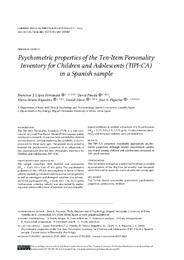Por favor, use este identificador para citar o enlazar este ítem:
https://hdl.handle.net/11000/36189Registro completo de metadatos
| Campo DC | Valor | Lengua/Idioma |
|---|---|---|
| dc.contributor.author | López-Fernández, Francisco J. | - |
| dc.contributor.author | Pineda, David | - |
| dc.contributor.author | Rivera-Riquelme, María | - |
| dc.contributor.author | Lloret, Daniel | - |
| dc.contributor.author | Piqueras, Jose A | - |
| dc.contributor.other | Departamentos de la UMH::Psicología de la Salud | es_ES |
| dc.date.accessioned | 2025-03-27T13:06:02Z | - |
| dc.date.available | 2025-03-27T13:06:02Z | - |
| dc.date.created | 2024 | - |
| dc.identifier.citation | Current Issues in Personality Psychology, 2024 | es_ES |
| dc.identifier.issn | 2353-4192 | - |
| dc.identifier.uri | https://hdl.handle.net/11000/36189 | - |
| dc.description.abstract | background The Ten-Item Personality Inventory (TIPI) is a non-commercial very brief Five-Factor Model (FFM) measure widely employed in research. Its use has been extended to children and adolescents, without exploring the suitability of its employment for these early ages. The present study aimed to examine the psychometric properties of an adaptation of this questionnaire (the Ten-Item Personality Inventory for Children and Adolescents, TIPI-CA). participants and procedure The sample comprised 2428 children and adolescents (Mage = 12.65, SD = 2.41, 47.16% girls). The psychometric properties of the TIPI-CA were explored in terms of factor validity (including measurement invariance across gender), as well as convergent and divergent validities in a subsample of 800 participants (Mage = 12.50, SD = 1.96, 49.1% girls). Furthermore, criterion validity was also tested by exploring associations with prosocial behavior and psychopatho logical problems in another subsample of 618 participants (Mage = 11.97, SD = 2.70, 53.2% girls). Finally, internal consistency and temporal stability were estimated too. results The TIPI-CA presented reasonably appropriate psychometric properties, although weaker discriminant validity was found among children and adolescents compared to TIPI adult versions. conclusions The instrument emerges as a useful tool to obtain a suitable approximation of the Big Five personality trait measures when time and/or space are scarce at early and young ages. | es_ES |
| dc.format | application/pdf | es_ES |
| dc.format.extent | 9 | es_ES |
| dc.language.iso | eng | es_ES |
| dc.publisher | Termedia Publishing | es_ES |
| dc.rights | info:eu-repo/semantics/openAccess | es_ES |
| dc.rights | Attribution-NonCommercial-NoDerivatives 4.0 Internacional | * |
| dc.rights.uri | http://creativecommons.org/licenses/by-nc-nd/4.0/ | * |
| dc.subject | Five-Factor Model | es_ES |
| dc.subject | personality assessment | es_ES |
| dc.subject | psychometric properties | es_ES |
| dc.subject | children | es_ES |
| dc.subject | adolescents | es_ES |
| dc.subject.other | CDU::1 - Filosofía y psicología::159.9 - Psicología | es_ES |
| dc.title | Psychometric properties of the Ten-Item Personality Inventory for Children and Adolescents (TIPI-CA) in a Spanish sample | es_ES |
| dc.type | info:eu-repo/semantics/article | es_ES |
| dc.relation.publisherversion | https://doi.org/10.5114/cipp/188360 | es_ES |

Ver/Abrir:
2024_Current_Issues_paper_published (2) (1).pdf
689,84 kB
Adobe PDF
Compartir:
 La licencia se describe como: Atribución-NonComercial-NoDerivada 4.0 Internacional.
La licencia se describe como: Atribución-NonComercial-NoDerivada 4.0 Internacional.
.png)